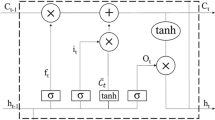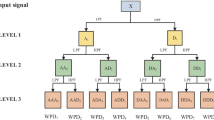Abstract
Precise predicting of rainfall is paramount for effective water resource management, ecological conservation, and the prevention of droughts and floods. Influenced by numerous variables, the process of rainfall is complex and the rainfall series exhibit high degrees of nonlinearity, making it challenging for traditional statistical prediction models to accurately capture the characteristics of rainfall series. Therefore, this paper proposes a new coupled model for predicting monthly rainfall based on Extreme-Point Symmetric Mode Decomposition (ESMD), Empirical Wavelet Transform (EWT), Singular Value Decomposition (SVD) and Long Short-Term Memory Neural Network (LSTM). By training and evaluating the ESMD-EWT-SVD-LSTM model on Kaifeng City’s monthly rainfall data from 2009 to 2020 and comparing its predictions with those of the ESMD-SVD-LSTM, SVD-LSTM, LSTM models, the analysis reveals that: the quadratic decomposition of ESMD-EWT and SVD denoising can further reduce the complexity of rainfall data, obtain more predictable feature IMFs, and enhance the precision in LSTM predicting; in comparison with alternative models, the ESMD-EWT-SVD-LSTM coupled model shows the highest accuracy in predicting results, with MAE of 4.96, RMSE of 6.13, and SI of 0.12, indicating that the ESMD-EWT-SVD-LSTM model has strong nonlinear process learning ability and accuracy in regional monthly rainfall prediction. This study can offer dependable scientific grounding and technical assistance for regional rainfall predicting, water resources planning, and disaster mitigation.







Similar content being viewed by others
Data Availability
The data that support the findings of this study are available on request.
References
Afshari Nia M, Panahi F, Ehteram M (2023) Convolutional neural network-ANN-E (Tanh): a new deep learning model for predicting rainfall. Water Resour Manag 37(4):1785–1810. https://doi.org/10.1007/s11269-023-03454-8
Aydin MC, Sevgi B (2022) Flood risk analysis using GIS-based analytical hierarchy process: a case study of Bitlis Province. Appl Water Sci 12(6):122. https://doi.org/10.1007/s13201-022-01655-x
Bakhshi Ostadkalayeh F, Moradi S, Asadi A, Moghaddam Nia A, Taheri S (2023) Performance improvement of LSTM-based deep learning model for streamflow forecasting using Kalman filtering. Water Resour Manag 37(8):3111–3127. https://doi.org/10.1007/s11269-023-03492-2
Byun J, Jun C, Kim J, Cha J, Narimani R (2023) Deep learning-based rainfall prediction using cloud image analysis. IEEE Trans Geosci Remote Sens 61:1–11. https://doi.org/10.1109/TGRS.2023.3263872
Chadalawada J, Havlicek V, Babovic V (2017) A genetic programming approach to system identification of rainfall-runoff models. Water Resour Manag 31:3975–3992. https://doi.org/10.1007/s11269-017-1719-1
Chen C, Zhang Q, Kashani MH, Jun C, Bateni SM et al (2022) Forecast of rainfall distribution based on fixed sliding window long short-term memory. Engineering Applications of Computational Fluid Mechanics 16(1):248–261. https://doi.org/10.1080/19942060.2021.2009374
Chen G, Wang WC (2022) Short-term precipitation prediction for contiguous United States using deep learning. Geophys Res Lett 49(8):e2022GL097904. https://doi.org/10.1029/2022GL097904
Chen YC, Gao JJ, Bin ZH, Qian JZ, Pei RL, Zhu H (2021) Application study of IFAS and LSTM models on runoff simulation and flood prediction in the Tokachi River basin. J Hydroinf 23(5):1098–1111. https://doi.org/10.2166/hydro.2021.035
Devi SR, Arulmozhivarman P, Venkatesh C, Agarwal P (2016) Performance comparison of artificial neural network models for daily rainfall prediction. Int J Autom Comput 13:417–427. https://doi.org/10.1007/s11633-016-0986-2
Ehteram M, Ahmed AN, Sheikh Khozani Z, El-Shafie A (2023) Convolutional neural network-support vector machine model-Gaussian process regression: a new machine model for predicting monthly and daily rainfall. Water Resour Manag 37(9):3631–3655. https://doi.org/10.1007/s11269-023-03519-8
Elsaraiti M, Merabet A (2021) Application of long-short-term-memory recurrent neural networks to forecast wind speed. Appl Sci 11(5):2387. https://doi.org/10.3390/app11052387
Fatimi AS, Anwar E, Shaikh T (2023) The precedent set by unprecedented rainfall: lessons to be learnt from disastrous flooding in Pakistan. Disaster Med Public Health Prep 17:e411. https://doi.org/10.1017/dmp.2023.79
Gao B, Huang X, Shi J, Tai Y, Zhang J (2020) Hourly forecasting of solar irradiance based on CEEMDAN and multi-strategy CNN-LSTM neural networks. Renew Energy 162:1665–1683. https://doi.org/10.1016/j.renene.2020.09.141
Gao Y, Wang B, Chen F, Zhang W, Zhou D, Wu F, Chen D (2023) Multi-step wind speed prediction based on LSSVM combined with ESMD and fractional-order beetle swarm optimization. Energy Rep 9:6114–6134. https://doi.org/10.1016/j.egyr.2023.05.034
Gilles J (2013) Empirical wavelet transform. IEEE Trans Signal Process 61(16):3999–4010. https://doi.org/10.1109/TSP.2013.2265222
Han L, Liang H, Chen H, Zhang W, Ge Y (2022) Convective precipitation nowcasting using U-net model. IEEE Trans Geosci Remote Sens 60:1–8. https://doi.org/10.1109/TGRS.2021.3100847
Hewamalage H, Bergmeir C, Bandara K (2021) Recurrent neural networks for time series forecasting current status and future directions. Int J Forecast 37(1):388–427. https://doi.org/10.1016/j.ijforecast.2020.06.008
Hochreiter S, Schmidhuber J (1997) Long short-term memory. Neural Comput 9(8):1735–1780. https://doi.org/10.1162/neco.1997.9.8.1735
Johny K, Pai ML, Adarsh S (2022) A multivariate EMD-LSTM model aided with time dependent intrinsic cross-correlation for monthly rainfall prediction. Appl Soft Comput 123:108941. https://doi.org/10.1016/j.asoc.2022.108941
Kajewska Szkudlarek J (2020) Clustering approach to urban rainfall time series prediction with support vector regression model. Urban Water J 17(3):235–246. https://doi.org/10.1080/1573062x.2020.1760319
Karijadi I, Chou SY, Dewabharata A (2023) Wind power forecasting based on hybrid CEEMDAN-EWT deep learning method. Renew Energy 218:119357. https://doi.org/10.1016/j.renene.2023.119357
Li CZ, Zhang L, Wang H, Zhang YQ, Yu FL, Yan DH (2012) The transferability of hydrological models under nonstationary climatic conditions. Hydrol Earth Syst Sci 16(4):1239–1254. https://doi.org/10.5194/hess-16-1239-2012
Liu Q, Yang J, Zhang K (2022) An improved empirical wavelet transform and sensitive components selecting method for bearing fault. Measurement 187:110348. https://doi.org/10.1016/j.measurement.2021.110348
Moraga JS, Peleg N, Molnar P, Fatichi S, Burlando P (2022) Uncertainty in high-resolution hydrological projections: partitioning the influence of climate models and natural climate variability. Hydrol Process 36(10):e14695. https://doi.org/10.1002/hyp.14695
Ni L, Wang D, Singh VP, Wu J, Wang Y, Tao Y, Zhang J (2020) Streamflow and rainfall forecasting by two long short-term memory-based models. J Hydrol 583:124296. https://doi.org/10.1016/j.jhydrol.2019.124296
Nourali M (2023) Improved treatment of model prediction uncertainty: estimating rainfall using discrete wavelet transform and principal component analysis. Water Resour Manag 37(11):4211–4231. https://doi.org/10.1007/s11269-023-03549-2
Olmo ME, Bettolli ML (2022) Statistical downscaling of daily precipitation over southeastern South America: assessing the performance in extreme events. Int J Climatol 42(2):1283–1302. https://doi.org/10.1002/joc.7303
Peng L, Wang L, Xia D, Gao Q (2022) Effective energy consumption forecasting using empirical wavelet transform and long short-term memory. Energy 238:121756. https://doi.org/10.1016/j.energy.2021.121756
Wang JL, Li ZJ (2013) Extreme-point symmetric mode decomposition method for data analysis. Adv Adapt Data Anal 5(03):1350015. https://doi.org/10.1142/s1793536913500155
Wu S, Hu X, Zheng W, He C, Zhang G, Zhang H, Wang X (2021) Effects of reservoir water level fluctuations and rainfall on a landslide by two-way ANOVA and K-means clustering. Bull Eng Geol Environ 80(7):5405–5421. https://doi.org/10.1007/s10064-021-02273-8
Yang J, Xiang Y, Sun J, Xu X (2022) Multi-model ensemble prediction of summer precipitation in China based on machine learning algorithms. Atmosphere 13(9):1424. https://doi.org/10.3390/atmos13091424
Zhang J, Chen X, Khan A, Zhang YK, Kuang X, Liang X, Taccari ML, Nuttall J (2021) Daily runoff forecasting by deep recursive neural network. J Hydrol 596:126067. https://doi.org/10.1016/j.jhydrol.2021.126067
Zhang J, Hou G, Ma B, Hua W (2018) Operating characteristic information extraction of flood discharge structure based on complete ensemble empirical mode decomposition with adaptive noise and permutation entropy. J Vib Control 24(22):5291–5301. https://doi.org/10.1177/1077546317750979
Zhang J, Li Z, Huang J, Cheng M, Li H (2022) Study on vibration-transmission-path identification method for hydropower houses based on CEEMDAN-SVD-TE. Appl Sci 12(15):7455. https://doi.org/10.3390/app12157455
Zhang X, Chen H, Wen Y, Shi J, Xiao Y (2023) A new water level prediction model based on ESMD−VMD−WSD−ESN. Stoch Env Res Risk A 37:3221–3241. https://doi.org/10.1007/s00477-023-02446-9
Zhang Y, Chen Y (2022) Application of hybrid model based on CEEMDAN, SVD, PSO to wind energy prediction. Environ Sci Pollut Res 29:22661–22674. https://doi.org/10.1007/s11356-021-16997-3
Zheng J, Su M, Ying W, Tong J, Pan Z (2021) Improved uniform phase empirical mode decomposition and its application in machinery fault diagnosis. Measurement 179:109425. https://doi.org/10.1016/j.measurement.2021.109425
Zhou Z, Ouyang Y, Li Y, Qiu Z, Moran M (2017) Estimating impact of rainfall change on hydrological processes in Jianfengling rainforest watershed China using BASINS-HSPF-CAT modeling system. Ecol Eng 105:87–94. https://doi.org/10.1016/j.ecoleng.2017.04.051
Zhu K, Yang Q, Zhang S, Jiang S, Wang T, Liu J, Ye Y (2023) Long lead-time radar rainfall nowcasting method incorporating atmospheric conditions using long short-term memory networks. Frontiers in Environmental Science 10:1054235. https://doi.org/10.3389/fenvs.2022.1054235
Zhuang X, Fan Y, Li Y, Wu C (2023) Evaluation climate change impacts on water resources over the upper reach of the Yellow River Basin. Water Resour Manag 37(6-7):2875–2889. https://doi.org/10.1007/s11269-023-03501-4
Acknowledgements
We are particularly grateful to the anonymous reviewers and editors for their comments.
Funding
This work was supported by Program for Innovative Research Team (in Science and Technology) in University of Henan Province (24IRTSTHN012) and National Natural Science Foundation of China (51779093).
Author information
Authors and Affiliations
Contributions
Conceptualization: Z. X. Methodology and analysis: L. Z; Z. X. Writing—original draft preparation: L. Z; Z. X. Writing—review and editing: L. Z; Z. X. Supervision: Z. X.
Corresponding author
Ethics declarations
Ethical Approval
All research activities conducted for this article have obtained ethical approval from the relevant institutional review board or ethics committee. This ensures that the research complies with ethical standards and safeguards the rights and well-being of the participants.
Consent to Participate
Participants involved in this study have provided informed consent to voluntarily participate. Clear and comprehensive information regarding the study’s purpose, procedures, and potential risks has been communicated, allowing participants to make informed decisions about their involvement.
Consent to Publish
Authors have obtained explicit consent from study participants, when applicable, for the publication of any identifiable information. This ensures respect for individuals’ privacy and confidentiality, aligning with ethical publishing practices.
Competing Interests
Authors disclose any competing interests that could influence the interpretation or presentation of the research. This includes financial interests, relationships, or affiliations that may be perceived as influencing the work.
Additional information
Publisher’s Note
Springer Nature remains neutral with regard to jurisdictional claims in published maps and institutional affiliations.
Highlights
(1) ESMD can decompose rainfall series into multiple real feature IMFs.
(2) Combining ESMD and EWT methods for data preprocessing can further simplify and extract information from rainfall series.
(3) The IMFs after ESMD-EWT decomposition and SVD processing can effectively improve the prediction accuracy of LSTM.
(4) The coupled model of ESMD-EWT-SVD-LSTM has a better prediction performance and strong applicability for nonlinear rainfall series.
Rights and permissions
Springer Nature or its licensor (e.g. a society or other partner) holds exclusive rights to this article under a publishing agreement with the author(s) or other rightsholder(s); author self-archiving of the accepted manuscript version of this article is solely governed by the terms of such publishing agreement and applicable law.
About this article
Cite this article
Li, Z., Zhang, X. A Novel Coupled Model for Monthly Rainfall Prediction Based on ESMD-EWT-SVD-LSTM. Water Resour Manage 38, 3297–3312 (2024). https://doi.org/10.1007/s11269-024-03815-x
Received:
Accepted:
Published:
Issue Date:
DOI: https://doi.org/10.1007/s11269-024-03815-x




